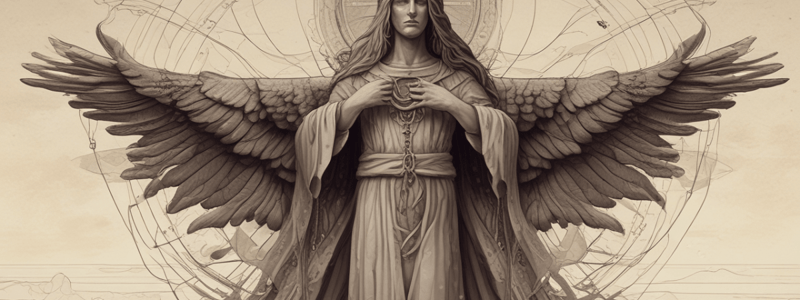Podcast
Questions and Answers
The offerer is responsible for sprinkling the blood around the altar.
The offerer is responsible for sprinkling the blood around the altar.
False (B)
The priest plays the primary role in the sacrificial system, selecting the animal, slaughtering it, and preparing it for the altar.
The priest plays the primary role in the sacrificial system, selecting the animal, slaughtering it, and preparing it for the altar.
False (B)
The guilt offering requires an additional 10% to be given to the priest or injured party.
The guilt offering requires an additional 10% to be given to the priest or injured party.
False (B)
Free will offerings are made to express sorrow and regret for the breach in the relationship with Yahweh.
Free will offerings are made to express sorrow and regret for the breach in the relationship with Yahweh.
The peace offering is for atonement.
The peace offering is for atonement.
The sin offering is made for intentional sins, while the guilt offering is made for the repercussions of unintentional sins.
The sin offering is made for intentional sins, while the guilt offering is made for the repercussions of unintentional sins.
The offerer has three days to consume the peace offering after bringing it to the priest.
The offerer has three days to consume the peace offering after bringing it to the priest.
The peace offering is a 'non-sweet savor' offering, which is not pleasing to Yahweh.
The peace offering is a 'non-sweet savor' offering, which is not pleasing to Yahweh.
The grain offering is used to illustrate the general principles of the sacrificial system.
The grain offering is used to illustrate the general principles of the sacrificial system.
The grain offering represents only the spiritual aspects of one's life dedicated to Yahweh.
The grain offering represents only the spiritual aspects of one's life dedicated to Yahweh.
The burnt offering is used to render tribute to the Lord.
The burnt offering is used to render tribute to the Lord.
In the peace offering, the priest eats part of the animal.
In the peace offering, the priest eats part of the animal.
The sin offering and guilt offering are brought for the same purpose.
The sin offering and guilt offering are brought for the same purpose.
The priest has a primary role in the selection of the animal for the burnt offering.
The priest has a primary role in the selection of the animal for the burnt offering.
The offerer is responsible for arranging the wood on the altar.
The offerer is responsible for arranging the wood on the altar.
The guilt offering requires an additional 15% to be given to the priest or injured party.
The guilt offering requires an additional 15% to be given to the priest or injured party.
The offerer does not play a significant role in the preparation of the animal for the altar.
The offerer does not play a significant role in the preparation of the animal for the altar.
The burnt offering is an example of a 'non-sweet savor' offering, which is not pleasing to Yahweh.
The burnt offering is an example of a 'non-sweet savor' offering, which is not pleasing to Yahweh.
The priestly instructions in Leviticus 6-7 emphasize the sin offering, highlighting its importance in re-establishing consecration to Yahweh.
The priestly instructions in Leviticus 6-7 emphasize the sin offering, highlighting its importance in re-establishing consecration to Yahweh.
The peace offering is only made when a vow is made and fulfilled.
The peace offering is only made when a vow is made and fulfilled.
The sin offering is made for the repercussions of those sins, while the guilt offering is made for unintentional sins.
The sin offering is made for the repercussions of those sins, while the guilt offering is made for unintentional sins.
The grain offering represents only the material aspects of one's life dedicated to Yahweh.
The grain offering represents only the material aspects of one's life dedicated to Yahweh.
The offerer's personal involvement is minimal in the sacrificial system, with the priest playing the primary role in the process.
The offerer's personal involvement is minimal in the sacrificial system, with the priest playing the primary role in the process.
Forgiveness is tied to the peace offering, and the sin and guilt offerings are not necessary for forgiveness.
Forgiveness is tied to the peace offering, and the sin and guilt offerings are not necessary for forgiveness.
The sacrificial system in Leviticus 1-7 is divided into only two types of offerings: 'sweet aroma' and 'non-sweet aroma' offerings.
The sacrificial system in Leviticus 1-7 is divided into only two types of offerings: 'sweet aroma' and 'non-sweet aroma' offerings.
Study Notes
- The sacrificial system involves two main aspects: offerings and priests.
- The burnt offering is a significant offering, with specific instructions in Leviticus 1:2-7, and is used to illustrate the general principles of the sacrificial system.
- A man, representing his family, brings the offering to the Lord, and selects the animal, ensuring it is a male without defect.
- The offerer brings the animal to the doorway of the Tent of Meeting, lays his hand on the head of the burnt offering, and slaughters it.
- The priest's role is to sprinkle the blood around the altar and arrange the wood, while the offerer skins and cuts the animal into pieces.
- The offerer is responsible for selecting the right animal, putting his hand on its head, slaughtering it, and cutting it into pieces, demonstrating personal involvement and identification with the sacrifice.
- The grain offering, peace offering, sin offering, and guilt offering follow similar patterns, with the offerer bringing the offering and the priest playing a secondary role.
- In the peace offering, the offerer eats part of the animal, and has two days to consume it, after which any remaining meat is burned.
- The sin and guilt offerings require restitution, with the guilt offering requiring an additional 20% to be given to the priest or injured party.
- The burnt offering is for atonement, while the grain offering is to render tribute to the Lord, and the peace offering is for a votive or free will offering.
- The offerer's personal involvement is crucial in the sacrificial system, as they select the animal, slaughter it, and prepare it for the altar, with the priest playing a secondary role in the process.• There are three types of offerings: thanksgiving, votive (or free will), and peace offerings, which are associated with a sense of harmony and fellowship between the worshipper and Yahweh.
• If God answers a prayer, a thanksgiving offering is to be made, which is a declaration of harmony and fellowship with Yahweh.
• If a vow is made, a peace offering is to be brought at the end of the vow, symbolizing the fulfillment of the promise.
• Free will offerings are made to express joy and gratitude for the harmony and fellowship with Yahweh.
• These three offerings are called "sweet aroma" offerings, bringing a soothing and pleasant smell to Yahweh.
• In contrast, sin and guilt offerings are "non-sweet savor" offerings, which are not pleasing to Yahweh.
• Sin offerings are made for unintentional sins, and guilt offerings are made for the repercussions of those sins.
• Both sin and guilt offerings are necessary to repair the breach in the relationship with Yahweh and those who have been sinned against.
• The structure of the offerings in Leviticus 1-7 is divided into sweet aroma and non-sweet aroma offerings, with the peace offering being the central and culminating offering.
• The priestly instructions in Leviticus 6-7 emphasize the peace offering, highlighting its importance in re-establishing consecration to Yahweh.
• The burnt offering deals with the past, recommitting oneself to wholehearted consecration to Yahweh, while the grain offering represents all that one has and is dedicated to Yahweh.
• The sin and guilt offerings repair the rupture in the relationship with Yahweh, and the peace offering re-establishes harmony and fellowship.
• Forgiveness is tied to atonement, and the sin and guilt offerings are the basis of forgiveness, as reiterated in Leviticus 4:20 and 26.
• The ultimate forgiveness comes through Christ, and these offerings anticipate and look forward to His ultimate sacrifice.
Studying That Suits You
Use AI to generate personalized quizzes and flashcards to suit your learning preferences.
Description
This quiz covers the two main aspects of the sacrificial system: offerings and priests. Learn about the different types of offerings, including burnt, grain, peace, sin, and guilt offerings, and their significance in the biblical context. Discover the role of the offerer and the priest in the sacrificial process and how it relates to atonement and forgiveness.



